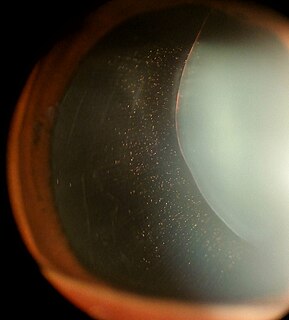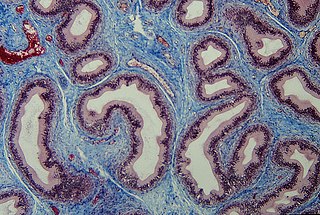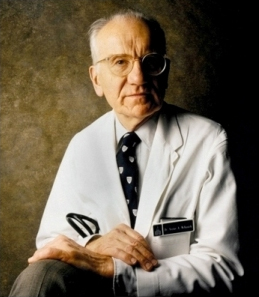Related Research Articles

Marfan syndrome (MFS) is a genetic disorder that affects the connective tissue. Those with the condition tend to be tall and thin, with long arms, legs, fingers, and toes. They also typically have overly-flexible joints and scoliosis. The most serious complications involve the heart and aorta, with an increased risk of mitral valve prolapse and aortic aneurysm. The lungs, eyes, bones, and the covering of the spinal cord are also commonly affected. The severity of the symptoms of MFS is variable.

Ehlers–Danlos syndromes (EDS) are a group of genetic connective-tissue disorders. Symptoms may include loose joints, joint pain, stretchy velvety skin, and abnormal scar formation. These can be noticed at birth or in early childhood. Complications may include aortic dissection, joint dislocations, scoliosis, chronic pain, or early osteoarthritis.

Connective tissue is one of the four basic types of animal tissue, along with epithelial tissue, muscle tissue, and nervous tissue. It develops from the mesoderm. Connective tissue is found in between other tissues everywhere in the body, including the nervous system. In the central nervous system, the three outer membranes that envelop the brain and spinal cord are composed of connective tissue. All connective tissue consists of three main components: fibers, ground substance and cells. Not all authorities include blood or lymph as connective tissue because they lack the fiber component. All are immersed in the body water. The cells of connective tissue include fibroblasts, adipocytes, macrophages, mast cells and leucocytes.
The National Institute of Arthritis and Musculoskeletal and Skin Diseases (NIAMS) is one of the institutes and centers that make up the National Institutes of Health, an agency of the United States Department of Health and Human Services (HHS).

Victor Almon McKusick was an American internist and medical geneticist, and Professor of Medicine at the Johns Hopkins Hospital, Baltimore. He was a proponent of the mapping of the human genome due to its use for studying congenital diseases. He is well known for his studies of the Amish. He was the original author and, until his death, remained chief editor of Mendelian Inheritance in Man (MIM) and its online counterpart Online Mendelian Inheritance in Man (OMIM). He is widely known as the "father of medical genetics".

Pulmonary fibrosis is a condition in which the lungs become scarred over time. Symptoms include shortness of breath, a dry cough, feeling tired, weight loss, and nail clubbing. Complications may include pulmonary hypertension, respiratory failure, pneumothorax, and lung cancer.
In genetics, expressivity is the degree to which a phenotype is expressed by individuals having a particular genotype. Expressivity is related to the intensity of a given phenotype; it differs from penetrance, which refers to the proportion of individuals with a particular genotype that actually express the phenotype.
A connective tissue disease (collagenosis) is any disease that has the connective tissues of the body as a target of pathology. Connective tissue is any type of biological tissue with an extensive extracellular matrix that supports, binds together, and protects organs. These tissues form a framework, or matrix, for the body, and are composed of two major structural protein molecules: collagen and elastin. There are many different types of collagen protein in each of the body's tissues. Elastin has the capability of stretching and returning to its original length—like a spring or rubber band. Elastin is the major component of ligaments and skin. In patients with connective tissue disease, it is common for collagen and elastin to become injured by inflammation (ICT). Many connective tissue diseases feature abnormal immune system activity with inflammation in tissues as a result of an immune system that is directed against one's own body tissues (autoimmunity).

Ligamentous laxity, or ligament laxity, means loose ligaments. Ligamentous laxity is a cause of chronic body pain characterized by loose ligaments. When this condition affects joints in the entire body, it is called generalized joint hypermobility, which occurs in about ten percent of the population, and may be genetic. Loose ligaments can appear in a variety of ways and levels of severity. It also does not always affect the entire body. One could have loose ligaments of the feet, but not of the arms.

Medical genetics is the branch of medicine that involves the diagnosis and management of hereditary disorders. Medical genetics differs from human genetics in that human genetics is a field of scientific research that may or may not apply to medicine, while medical genetics refers to the application of genetics to medical care. For example, research on the causes and inheritance of genetic disorders would be considered within both human genetics and medical genetics, while the diagnosis, management, and counselling people with genetic disorders would be considered part of medical genetics.

Hypermobility, also known as double-jointedness, describes joints that stretch farther than normal. For example, some hypermobile people can bend their thumbs backwards to their wrists, bend their knee joints backwards, put their leg behind the head or perform other contortionist "tricks." It can affect one or more joints throughout the body.
A systemic disease is one that affects a number of organs and tissues, or affects the body as a whole.

Loeys–Dietz syndrome (LDS) is an autosomal dominant genetic connective tissue disorder. It has features similar to Marfan syndrome and Ehlers–Danlos syndrome. The disorder is marked by aneurysms in the aorta, often in children, and the aorta may also undergo sudden dissection in the weakened layers of the wall of the aorta. Aneurysms and dissections also can occur in arteries other than the aorta. Because aneurysms in children tend to rupture early, children are at greater risk for dying if the syndrome is not identified. Surgery to repair aortic aneurysms is essential for treatment.
Congenital contractural arachnodactyly (CCA), also known as Beals-Hecht syndrome, is a rare autosomal dominant congenital connective tissue disorder. As with Marfan syndrome, people with CCA typically have an arm span that is greater than their height and very long fingers and toes. However, Beals and Hecht discovered in 1972 that, unlike Marfan's, CCA is caused by mutations to the fibrillin-2 (FBN2) gene rather than the fibrillin-1 (FBN1) gene.
An overlap syndrome is a medical condition which shares features of at least two more widely recognised disorders. Examples of overlap syndromes can be found in many medical specialties such as overlapping connective tissue disorders in rheumatology, and overlapping genetic disorders in cardiology.
The Lupus Research Alliance (LRA) is an American voluntary health organization based in New York City whose mission is to find better treatments and ultimately prevent and cure systemic lupus erythematosus, a debilitating autoimmune disease, through supporting medical research. The organization was born from the merger of three organizations: the Lupus Research Institute (LRI) and the S.L.E. Lupus Foundation with the Alliance for Lupus Research (ALR), which was founded by Robert Wood “Woody” Johnson IV — a member of the Johnson & Johnson family and owner of the New York Jets. As of 2020 the LRA's cumulative research commitment was $220,000,000.

The mission of the Foundation Fighting Blindness is to fund research that will lead to the prevention, treatment and cures for the entire spectrum of retinal degenerative diseases, including retinitis pigmentosa, macular degeneration, Usher syndrome, Stargardt disease and related conditions. These diseases, which affect more than 10 million Americans and millions more throughout the world, often lead to severe vision loss or complete blindness.
The Dravet Syndrome Foundation (DSF) is a volunteer run, non-profit organization based in the United States. The mission of the foundation is to raise research funds for Dravet's syndrome and related epilepsies, while providing support to affected individuals and families. The Dravet Syndrome Foundation is listed as a research and support organization on National Organization of Rare Diseases's (NORD) database.
Uta Francke is a German-American physician-geneticist known for her accomplishments in mapping genes to specific chromosome locations and discovering the genes and underlying mutations responsible for Prader-Willi and Rett syndromes. Her work on detailed mapping of human chromosome laid the foundation of the Human Genome Project and discovery of many other rare genetic disorders. She is currently a professor of Genetics and Pediatrics Emerita at Stanford University. She has also served as a consultant to 23andMe Inc since 2007, and as a part-time employee from 2010-2013.

The zebra print ribbon is the emblem for neuroendocrine tumors including carcinoid cancer, Ehlers-Danlos Syndromes, and awareness of other rare diseases.
References
- ↑ "How We Help". The Marfan Foundation. Retrieved 2014-09-14.
- ↑ "Celebrate National Marfan Foundation's 30th Anniversary by Voting in Chase Community Giving". LongIsland.com. Retrieved 2014-09-14.
- ↑ "The Marfan Foundation Adopts New Brand to Better Reflect its Mission for Marfan Syndrome and Related Disorders". PRWeb. August 5, 2013. Retrieved 2014-09-14.
- ↑ "Boards and Staff". The Marfan Foundation. Retrieved 2014-09-16.
- ↑ Padron, Mayte (2020-01-24). "Local 10 is walking for The Marfan Foundation". WPLG. Retrieved 2020-09-08.
- ↑ "Walk for Victory at TeWinkle Park to honor Rare Disease Day". Daily Pilot. 2020-02-29. Retrieved 2020-09-08.